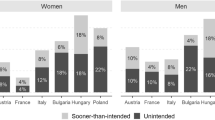Abstract
Objectives: This article reviews the history of the measurement of unwanted and unintended pregnancy in fertility surveys in the United States. These concepts were developed in order to help explain trends and differences in birth rates in the United States. Background: Unwanted fertility was first measured systematically in a survey in Indianapolis in 1941. The first national surveys to measure the concept of unwanted fertility were the 1955 and 1960 Growth of American Families Studies. All three of these surveys were limited to married women. In the 1965 National Fertility Survey, the concept of mistimed births was introduced. The 1973, 1976, 1982, and 1988 National Survey of Family Growth (NSFG) continued to measure trends in unwanted and mistimed fertility, while expanding the population interviewed, from currently married to all marital statuses. The 1993 and 2001 NSFGs have enriched the data on wantedness with new measures of ambivalence and the strength of feelings about having children. Conclusion: Measures of unwanted fertility, while imperfect, have been useful and will continue to be improved in the future.
Similar content being viewed by others
REFERENCES
Pearl R. The biology of population growth. New York: Alfred A. Knopf, 1925.
Pearl R. The natural history of population. New York: Oxford University Press, 1939.
Whelpton PK, Kiser CV, editors. Social and psychological factors affecting fertility. New York: Milbank Memorial Fund, 5 vols., 1946, 1950, 1952, 1954, 1958.
Whelpton PK, Kiser CV. Social and psychological factors affecting fertility. IV. Developing the schedules and choosing the type of couples and the area to be studied. Milbank Memorial Fund Q 1945;23:386–409.
Whelpton PK, Kiser CV. Social and psychological factors affecting fertility. VI. The planning of fertility. Milbank Memorial Fund Q 1947;35(1):63–111.
Freedman R, Whelpton PK. Social and psychological factors affecting fertility. XII. The relationship of general planning to fertility planning and fertility rates. Milbank Memorial Fund Q 1951;29:218–43.
Freedman R, Whelpton PK, Campbell AA. Family planning, sterility, and population growth. New York: McGraw–Hill, 1959.
Whelpton, PK. Cohort fertility. Princeton, NJ: Princeton University Press, 1954.
Whelpton PK, Campbell AA, Patterson JE. Fertility and family planning in the United States. Princeton NJ: Princeton University Press, 1966.
Ryder, NB, Westoff, CF. Reproduction in the United States 1965. Princeton, NJ: Princeton University Press, 1971.
Westoff CF, Ryder NB. The contraceptive revolution. Princeton NJ: Princeton University Press, 1977.
U.S. Commission on Population Growth and the American Future. Population and the American future.Washington, DC: U.S. Government Printing Office, 1972:145.
Williams LB, Pratt WF. Wanted and unwanted childbearing in the United States: 1973–88. Advance data from vital and health statistics of the National Center for Health Statistics, No. 189, 1990.
Abma J, Chandra A, Mosher WD, Peterson LS, Piccinino LJ. Fertility, family planning, and women's health: New data from the 1995 National Survey of Family Growth, National Center for Health Statistics, Vital and Health Statistics, Series 23, No. 19. Data from the National Survey of Family Growth, DHHS Publication No. (PHS) 97-1995, Washington DC: U.S. Government Printing Office, May 1997.
Brown SS, Eisenberg L, editors. The best intentions: Unintended pregnancy and the well-being of children and families. Washington, DC: National Academy Press, 1995.
Author information
Authors and Affiliations
Rights and permissions
About this article
Cite this article
Campbell, A.A., Mosher, W.D. A History of the Measurement of Unintended Pregnancies and Births. Matern Child Health J 4, 163–169 (2000). https://doi.org/10.1023/A:1009519329226
Issue Date:
DOI: https://doi.org/10.1023/A:1009519329226




